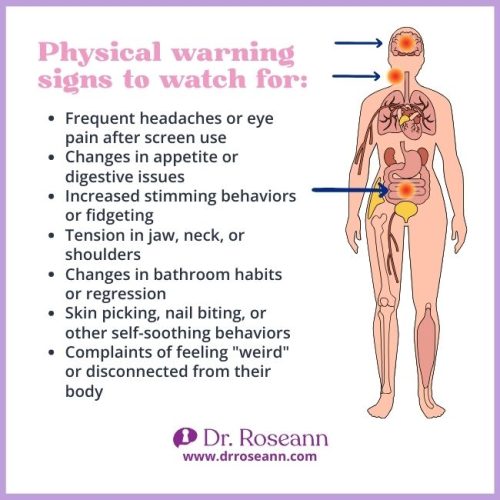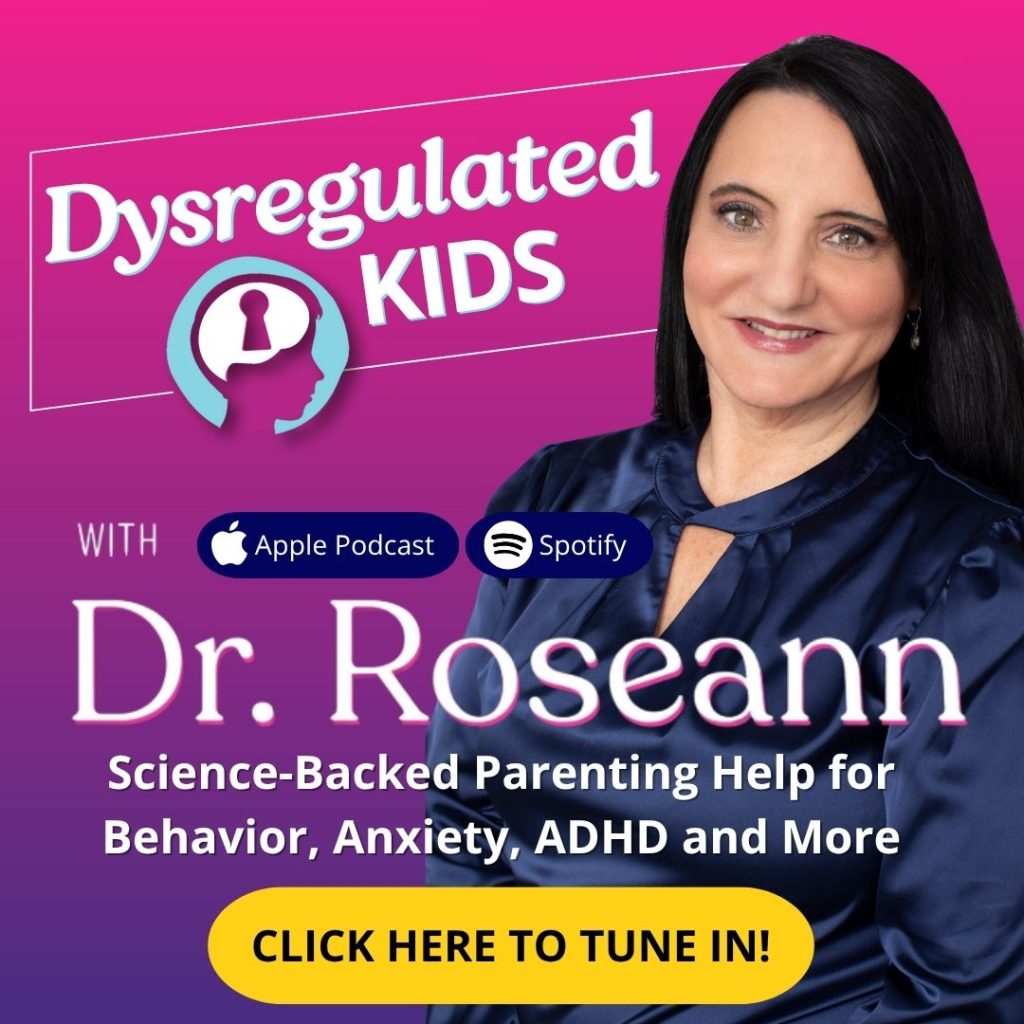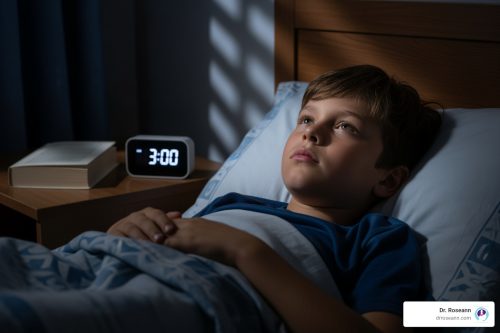Estimated reading time: 7 minutes
Most parents think screen time just makes kids “hyper” or “lazy.” What if I told you it can rewire their brain’s stress system — and you might already be seeing the signs?
I’ve seen screens trigger meltdowns, anxiety, withdrawal, and even physical stress. It’s not about parenting style—it’s about understanding your child’s brain and stepping in before screen habits shape their emotional health.
In this guide, I’ll walk you through:
- The emotional and physical red flags of screen time overload
- The brain science behind screen-induced dysregulation
- Practical, calm-first strategies to set healthy limits without constant battles
If you’ve ever wondered whether screens are really affecting your child — this might be the missing piece you’ve been looking for.
Emotional Red Flags That Signal Screen Time Overload
Screen time dysregulation often appears emotionally first. Explosive reactions when screens end, flat moods offline, and trouble transitioning between digital and real life are your child’s nervous system asking for help.
Key emotional warning signs:
- Rage responses to screen limits that seem disproportionate
- Emotional numbness or disconnection when not using devices
- Increased irritability throughout the day, especially before screen access
- Difficulty finding joy in previously enjoyed offline activities
- Heightened sensitivity to sensory input after screen use
Sarah, mom of 8-year-old Emma with ADHD, noticed meltdowns when tablet time ended—and an unsettling emptiness when Emma wasn’t on it, as if nothing else mattered.
These aren’t signs of defiance or “screen addiction”—they’re neurobiological responses to dysregulation that your child can’t control through willpower alone.

Why Screens Spike Mood Swings and Tantrums in Sensitive Kids
Dysregulated children are more easily overwhelmed by digital stimulation. Rapid scene changes, unpredictable rewards, and constant input can quickly hyperactivate their sensitive nervous systems, making it harder to stay emotionally balanced.
Why dysregulated kids struggle more:
- Slower sensory processing gets overwhelmed by rapid visual changes
- Executive function challenges make it harder to self-monitor usage
- Heightened dopamine sensitivity creates stronger cravings and crashes
- Difficulty with transitions makes stopping feel traumatic
- Overstimulated fight-or-flight system stays activated longer
Dr. Victoria Dunckley, author of Reset Your Child’s Brain, says kids with developmental or mental health issues are more vulnerable to screen effects because their nervous systems are already stressed. Lisa, mom of Jake with autism, saw hours-long tantrums after gaming and realized the games were fully dysregulating him.
The Neuroscience Behind Screen-Induced Dysregulation
Screen time can hijack a child’s developing reward system with unpredictable dopamine hits, creating emotional overwhelm. For kids with neurological differences, this happens faster and more intensely.
What happens in the dysregulated brain:
- Prefrontal cortex (executive functions) goes offline during intense screen use
- Dopamine pathways become overstimulated, leading to tolerance and cravings
- Stress hormones like cortisol remain elevated hours after screen use
- Default mode network struggles to activate, impacting self-reflection and emotional processing
Brain Science Spotlight
Research from Harvard Medical School shows excessive screen time in kids with ADHD can alter brain connectivity, overstimulating reward pathways and reducing interest in slower, real-world activities.
This discovery helps us understand why your child might seem “addicted” to screens while showing little interest in toys, books, or outdoor play. When dopamine pathways are overstimulated, children experience what researchers call “anhedonia”—the inability to feel pleasure from normal activities. This isn’t willful defiance—it’s neurobiology in action.
What this means for your family: Your child’s screen struggles aren’t about willpower or character—their brain literally needs time to recalibrate after digital overstimulation.
How Screen Time Sabotages Sleep and Emotional Recovery
Screen time and sleep disruption create a vicious cycle that worsens dysregulation. For sensitive kids, mental overstimulation from screens can be even more damaging than blue light, making it harder for the brain to process emotions and restore balance overnight.
Dr. Matthew Walker of UC Berkeley explains: “Screen use within two hours of bedtime can delay sleep by up to an hour in sensitive children, triggering emotional challenges the next day.”
Maria saw this with her 9-year-old son: “Once we removed bedtime screens, his morning meltdowns disappeared.”

The Hidden Link Between Screens and Social Withdrawal in Kids
Digital isolation in dysregulated kids often looks like preference but is really a nervous system coping strategy. When real-world interactions feel overwhelming, screens offer predictable comfort—sometimes replacing face-to-face connections entirely.

Dr. Roseann’s Therapist Tip
I’ve seen that social withdrawal around screens often reflects a dysregulated nervous system seeking predictability. Start with connection before correction—join your child’s digital world before inviting them into yours.
Try this today: Sit with your child during their screen time for 10 minutes without judgment. Ask genuine questions about what they’re watching or playing.
Why it works: This builds trust and helps you understand what your child finds regulating about their screen activities, so you can eventually offer offline alternatives that meet the same needs.
Remember: Your child isn’t choosing screens over you—they’re choosing regulation over overwhelm. Let’s calm the brain first, then build connection.
Physical Clues That Your Child’s Screen Use Is Too Much
Physical symptoms of screen overload often show up before emotional ones, especially in dysregulated kids. Beyond eye strain or poor posture, these signs reflect a nervous system in overdrive from too much stimulation and too little movement.
Physical warning signs to watch for:
- Frequent headaches or eye pain after screen use
- Changes in appetite or digestive issues
- Increased stimming behaviors or fidgeting
- Tension in jaw, neck, or shoulders
- Changes in bathroom habits or regression
- Skin picking, nail biting, or other self-soothing behaviors
- Complaints of feeling “weird” or disconnected from their body

Mark noticed his 11-year-old son David, who has SPD, was getting terrible headaches every afternoon. They tried new glasses, changed the lighting, and even checked for allergies. The headaches finally stopped when they cut back David’s after-school gaming — the screens were making him sick.
The body-brain connection: Physical symptoms aren’t separate from emotional dysregulation—they’re part of the same overwhelmed nervous system trying to find balance.
Creating a Calm-First Approach to Digital Boundaries
Traditional screen limits can escalate dysregulation. Calm-first parenting focuses on the nervous system, recognizing that struggles with transitions and impulse control aren’t defiance.
Calm-first boundary strategies:
- Preview transitions 30 minutes, 15 minutes, and 5 minutes before ending screen time
- Offer connection choices: “When screen time ends, would you like to read together or take a walk?”
- Create transition objects: Special snacks, music, or activities that bridge digital and offline time
- Validate feelings: “It’s hard to stop something fun. Your brain needs time to switch gears.”
- Plan engaging alternatives: Have specific, appealing activities ready for post-screen time

As Dr. Ross Greene notes, kids do well if they can. Screen time battles become opportunities to teach regulation skills and build connection.
This approach transforms screen time battles into opportunities for nervous system regulation and connection.
Why Regulating Screen Time Is Harder for Dysregulated Brains
Executive function challenges make self-limiting screen use especially hard for kids with ADHD, autism, anxiety, and other neurological differences. The same brain-based struggles that affect homework or transitions also impact digital boundaries.
Why they struggle:
- Poor time awareness during engaging activities
- Hyperfocus and tunnel vision
- Strong dopamine-seeking when baseline is low
- Transitions feel overwhelming
- Sensory differences make screens feel calming
The solution isn’t elimination—it’s working with their brain, not against it.
Summary: Moving Forward with Hope and Understanding
Excessive screen time can impact dysregulated kids — but with brain-based strategies, change is possible. Your child’s challenges aren’t about bad parenting; they’re about a sensitive nervous system needing the right support. It’s gonna be OK.
Key takeaways:
- Screen time affects dysregulated kids differently
- Physical and emotional symptoms can signal overwhelm
- Calm-first strategies work better than strict limits
- Struggles are rooted in neurobiology, not choice
Next step:
Sign up for The Dysregulation Insider and get weekly science-backed tips, strategies, and tools to help you manage screen time, reduce meltdowns, and bring more calm into your home.
FAQs
How much screen time is too much for a dysregulated child?
There’s no set number — watch behavior, sleep, and mood. If meltdowns, withdrawal, or sleep issues increase, it’s too much.
Can screen time ever help dysregulated kids?
Yes — when used intentionally for learning, regulation, or connection. Avoid passive use and keep offline activities a priority.
What if my child melts down when I set limits?
This often signals overwhelm, not defiance. Start small, give warnings, and co-regulate during transitions.
Are educational screens better than entertainment?
They can be, but the nervous system still reacts to the screen itself. Balance with offline learning and movement.
How long to reset a child’s screen habits?
Mood and behavior may improve in 1–2 weeks; full regulation can take 4–6 weeks.
Citations
Lissak, G. (2018). Adverse physiological and psychological effects of screen time on children and adolescents: Literature review and case study. Environmental Research, 164, 149–157. https://doi.org/10.1016/j.envres.2018.01.015
Tamana, S. K., Ezeugwu, V., Chikuma, J., Lefebvre, D. L., Azad, M. B., Moraes, T. J., … & Subbarao, P. (2019). Screen-time is associated with inattention problems in preschoolers: Results from the CHILD birth cohort study. PLOS ONE, 14(4), e0213995. https://doi.org/10.1371/journal.pone.0213995
Christakis, D. A., Ramirez, J. S. B., Ferguson, S. M., Ravinder, S., & Ramirez, J.-M. (2018). How early media exposure may affect cognitive function: A review of results from observations in humans and experiments in mice. Proceedings of the National Academy of Sciences, 115(40), 9851–9858. https://doi.org/10.1073/pnas.1711548115
Twenge, J. M., & Campbell, W. K. (2018). Associations between screen time and lower psychological well-being among children and adolescents: Evidence from a population-based study. Preventive Medicine Reports, 12, 271–283. https://doi.org/10.1016/j.pmedr.2018.10.003
Always remember… “Calm Brain, Happy Family™”
Disclaimer: This article is not intended to give health advice and it is recommended to consult with a physician before beginning any new wellness regime. *The effectiveness of diagnosis and treatment vary by patient and condition. Dr. Roseann Capanna-Hodge, LLC does not guarantee certain results.
Are you looking for SOLUTIONS for your struggling child or teen?
Dr. Roseann and her team are all about science-backed solutions, so you are in the right place!










